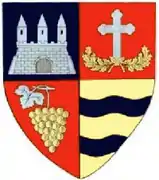Sântana
Sântana (Romanian pronunciation: [sɨnˈtana]; German: Neusanktanna; Hungarian: Újszentanna) is a town in north-western Romania, in the county of Arad. Declared a town in 2003, it administers one village, Caporal Alexa (Erdőskerek).
Sântana | |
|---|---|
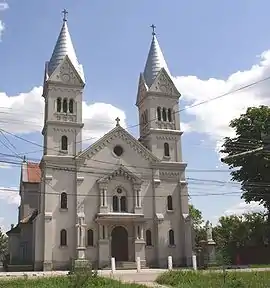 | |
 Coat of arms | |
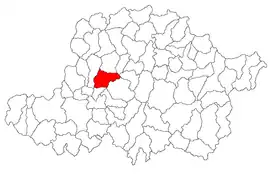 Location of Sântana | |
 Sântana Location in Romania | |
| Coordinates: 46°21′N 21°30′E | |
| Country | Romania |
| County | Arad |
| Government | |
| • Mayor (2020–2024) | Daniel-Sorin Tomuța[1] (PNL) |
| Area | 107.14 km2 (41.37 sq mi) |
| Elevation | 99 m (325 ft) |
| Population (2021-12-01)[2] | 12,460 |
| • Density | 120/km2 (300/sq mi) |
| Time zone | EET/EEST (UTC+2/+3) |
| Postal code | 317280 |
| Vehicle reg. | AR |
| Website | www |
Geography
The town is situated in the northern part of the Arad Plateau, at a 29 km (18 mi) distance from the county seat, Arad. It is traversed by county roads DJ791 and DJ792C.
Population
| Year | Pop. | ±% |
|---|---|---|
| 2002 | 12,936 | — |
| 2011 | 10,725 | −17.1% |
| 2021 | 12,460 | +16.2% |
| Source: Census data | ||
At the 2021 census, Sântana had a population of 12,460.[3] At the census from 2011, the town had 10,725 inhabitants; of those, 84.89% were Romanians, 9.57% Roma, 3.14% Germans, 2.07% Hungarians, and 0.4% of other or undeclared nationalities. Furthermore, 79.6% were Romanian Orthodox, 11.5% Pentecostal, 5.5% Roman Catholic, and 1.2% Baptist.
History
The first documentary record of the locality under the name Sântana goes back to the year 1828. The settlement is the result of the continuous development of Comlăuș, a locality mentioned already in 1334. Caporal Alexa was mentioned in 1334 when it was called Kerecton. Until 1926, it was called Cherechiu, which is still its colloquial name.
Economy
Although the economy of the town is prevalent agricultural, the secondary and tertiary economic sectors have also developed recently. Sântana is an important centre of vineyards.
Tourism
Its status as a significant road and railway junction can be used also for the promotion and improvement of the tourism. The specific architecture, the historical and architectural monuments as the "Convictului" building, the copyhold house and the fortifications called "Cetatea veche" are only a few of the locality's touristic sights.
Gallery
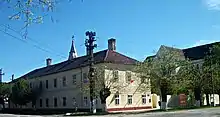
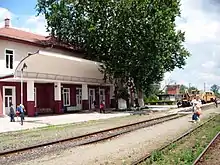
References
- "Results of the 2020 local elections". Central Electoral Bureau. Retrieved 8 June 2021.
- "Populaţia rezidentă după grupa de vârstă, pe județe și municipii, orașe, comune, la 1 decembrie 2021" (XLS). National Institute of Statistics.
- "Populația rezidentă după grupa de vârstă, pe județe și municipii, orașe, comune, la 1 decembrie 2021" (in Romanian). INSSE. 31 May 2023.
